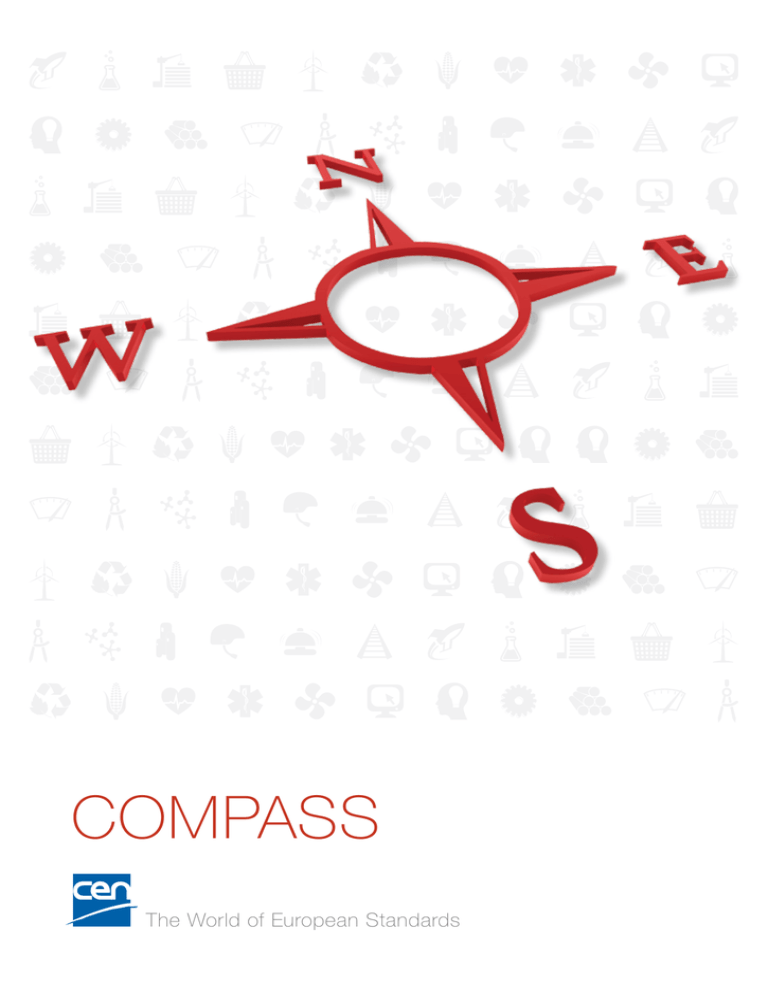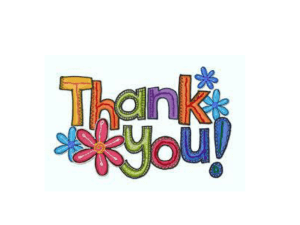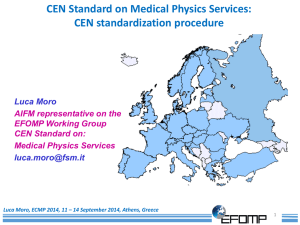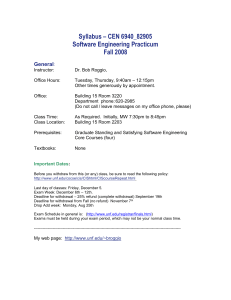CEN Compass - The world of European Standards
advertisement

COMPASS The World of European Standards 3 STANDARDS WORK Can you imagine… a Europe with different credit card sizes, a Europe where you couldn’t be certain that petrol was the same in every country or where Genetically Modified Organisms in food were classified differently? A Europe like that would be chaotic for all of its citizens and daily life would be far more complicated. “Standardization facilitates the exchange of goods and services by eliminating technical barriers.” Fortunately, the free movement of goods, persons, services and capital is smoothly becoming a reality in today’s single market Europe. Trade barriers are being eliminated through the development of common European Standards. It is CEN’s mission to develop European Standards. In this role, it is joined by its sister European Standards Organizations: CENELEC, specializing in electrotechnical standardization and ETSI, dealing with standardization for information and communication technology. GOOD NEWS FOR CONSUMERS AND PRODUCERS Consumers and producers alike benefit from standardization through increased product safety and quality as well as lower prices. With one common standard for 31 European countries, a product can reach a far wider market with much lower development and testing costs. Manufacturers benefit from being able to use a broader basis of external suppliers, from greater quality assurance, and increased efficiency. Customers are more likely to accept a product or service which they can trust. “Standards belong to the knowledge economy that underpins European industry and society.” With its commitment to reflect innovation and the results of research and development, CEN is able to respond to new market demands and European policies. 4 THE PROCESS BEYOND EUROPE European Standards are based on a consensus which reflects the economic and social interests of 31 CEN Member countries channeled through their National Standards Bodies (NSBs). Most standards are initiated by industry. Other standardization projects can come from consumers, Small and Medium Enterprises or associations, to name some other sources. European Standards are drafted in a global perspective. CEN has signed the ‘Vienna Agreement’ with the International Organization for Standardization (ISO) through which common European and international standards can be developed in parallel. More than 30% of the European Standards adopted by CEN are identical to international standards. These EN/ ISO standards have the dual benefits of automatic and identical implementation in 31 CEN Member countries, and global applicability. In addition to the EN/ISO Standards, a number of ENs developed by CEN are closely linked to ISO standards. In addition, many standards are developed to support European legislation. ‘Reference to standards’ within a legislative text is viewed as a more effective means of ensuring that products meet the essential health and safety requirements of legislation than the writing of detailed laws. This allows both processes to support each other, without causing a slowdown. Besides European Standards, CEN produces other reference documents which can be developed quickly and easily: Workshop Agreements, Technical Specifications, Technical Reports and Guides. WHAT STANDARDS DO FOR YOU Standards enhance the safety of products Standards encourage economies of scale Standards enable manufacturers to comply with European legislation Standards promote the interoperability of products and services Standards facilitate the uptake of innovation in the marketplace Standards encourage greater competition Standards facilitate trade by diminishing trade barriers Standards support environmental sustainability Standards reflect the outcome of research and development Standards promote common understanding 5 HOW TO PARTICIPATE IN STANDARDIZATION Standards are driven by business and drafted by experts in the field. In building European consensus, industry, trade federations, public authorities, academia and NGO representatives are invited to contribute to the standardization process. It is this open participation, which accounts for the strength of European standardization. “A European Standard is shaped by those who contribute to its development.” The route for participating in the development of European Standards is through National Standards Bodies. They send balanced delegations to represent the concerned interests in a standardization project. European trade associations and interest groups – representing environmentalists, consumers, trade unions, as well as small and medium enterprises, amongst others – also have the opportunity to contribute to the development of a standard. PARTICIPATION COUNTS Participation in the process allows a stakeholder to anticipate changes to standards in their sector as well as have a say in the content. A manufacturer wishing to participate in the CEN process contacts his National Standards Body, either directly or through a trade association. Through the National Standards Body, the manufacturer can become involved in a national ‘mirror committee’, which is responsible for developing the national position on a particular standard and presenting this position to the relevant CEN Technical Committee. It may also be possible to become a member of the national delegation to the CEN Technical Committee or to be nominated to serve as an expert in one of the Working Groups. “One European Standard is identical from Portugal to Finland and from Cyprus to Iceland.” 6 DEVELOPING A EUROPEAN STANDARD STARTING THE WORK PUBLIC COMMENT – A FURTHER STRENGTH A proposal for a European Standard may come from any interested party. Most are presented by the National Standards Bodies and, where European legislation is concerned, the European Commission (EC) and the European Free Trade Association (EFTA). Once the draft of a European Standard is prepared, it is released for public comment, a process known in CEN as the ‘CEN Enquiry’. During the public commenting stage, everyone who has an interest (e.g. manufacturers, public authorities, consumers, etc.) may comment on the draft. These views are collated by the National Standards Bodies and analyzed by the CEN Technical Committee. Taking into account the time required and the resources available, the appropriate CEN Technical Committee makes a decision on the adoption of the proposal. An adopted standardization project is allocated to one of the Working Groups for the drafting of the standard. Working Groups respond to the Technical Committee. If the proposal is for a new field of standardization activity, a decision is first made by the CEN Technical Board, who then sends the work to a new or existing Technical Committee. One of the values of CEN is that, once a standardization project has been adopted, the National Standards Bodies put all national activity within the scope of the project on hold. No new projects are initiated, nor are revisions of existing standards undertaken at a national level. This obligation is called ’standstill’ and allows efforts to be focused on European harmonization. ADOPTION BY WEIGHTED VOTE Taking into consideration the comments resulting from the CEN Enquiry, a final version is drafted, which is then submitted to the CEN Members for a weighted formal voting. 1 EUROPEAN STANDARD = 31 NATIONAL STANDARDS After ratification by CEN, each of the National Standards Bodies adopts the European Standard as an identical national standard and withdraws any national standards which conflict with the new European Standard. Hence one European Standard becomes the national standard in the 31 member countries of CEN. For example, the European Standard on toy safety, EN 71, has been adopted as NF EN 71 by AFNOR in France and as EVS EN 71 by EVS in Estonia. These standards are made available by the National Standards Body in each country. 7 The standards making process A key feature in the development of a European Standard (EN), and one from which it gains strength and legitimacy, is agreement of all interested parties. Consensus-building can be time consuming; however, in 2002, CEN implemented a system to deliver ENs in three years. Proposal Acceptance Drafting 3 YEARS CEN Enquiry Adoption by weighted vote Publication of the European Standard (EN) userS The flowchart below shows the typical process for the proposal, development, adoption and publication of a European Standard by a Technical Committee. Other options exist, including the parallel development of common standards with ISO. Any interested party is able to introduce proposals for new work to CEN. Once the proposal is accepted, national work is frozen in 31 countries (standstill). Appointed experts develop a first draft (Working Group). The call for public enquiry in 31 countries enables 420 million European citizens to comment on the draft standard. The final draft standard is created taking into consideration the comments from the enquiry. Each EN is published identically by the standards bodies in 31 countries. Conflicting national standards are withdrawn. EUROPEAN STANDARDIZATION ADAPTS TO THE NEED OF THE CUSTOMERS In addition to ENs, CEN produces CEN Workshop Agreements and CEN Technical Specifications. These deliverables have streamlined processes and quicker adoption procedures. CEN Workshop Agreement (CWA) CWAs are developed in CEN Workshops open to anyone with an interest in the development of the deliverable. There is no geographical limit on participation and hence participants may come from outside Europe. The development time of a CWA is on average between 10-12 months. CWAs do not have the status of a European Standard and there is no obligation for the National Standards Bodies to adopt them as national standards. A separate brochure concerning CEN Workshops is available. CEN Technical Specification (CEN/TS) can be used by CEN Technical Committees as a European Pre-Standard for innovative features of upstream technology, or when various alternatives need to coexist in anticipation of future harmonization. As with the CWAs, TSs do not have the status of a European Standard and are not adopted as national standards. 8 THE CEN SECTORS Standards are everywhere in daily life each time quality, efficiency, security and compatibility are at stake. Tables, doors, paper sizes, and railway tracks are all produced according to a standard. Training and services, for example of call centre operators or translators, may also be carried out in accordance with a European Standard. CEN covers most areas of economic activity, and provides an individual response to sector needs. The CEN-CENELEC Management Centre (CCMC) in Brussels, which offers its services to the decentralized CEN network, also has specialists who can advise and support standardization activities. Our sectors are: Air and space – aerospace and aeronautics, air traffic management and product assurance, safety and technical requirements relating to space systems and activities, etc. Chemistry – petroleum products, paints, varnishes, adhesives, soil improvers, explosives for civil use, pyrotechnics, etc. Construction – structures, products, materials, equipment, but also fire resistance, geotextiles, energy efficiency of buildings, etc. Consumer products – toys, gymnastics, sports and playground equipment, textiles, furniture, child care articles, etc. Energy – gas and water supplies, power engineering solarsystems, fuels, energy management, smart grids, etc. Environment – water and air quality, waste management, biofuels, recovered fuels, etc. Food – food analysis, animal feeding stuffs, detection of genetically modified organisms, articles in contact with food, etc. Health and safety – occupational health and safety (health and safety on the work floor) and personal protective equipment (protective clothing and devices, such as head, eye, hearing, foot, arm protectors, etc.) Healthcare – medical devices, surgical implants, health informatics, healthcare services, dental materials, etc. Heating, ventilation and air conditioning (HVAC) – gas appliances, oil and solid fuel appliances, refrigeration, heatpumps, cleanrooms, etc. ICT – Information and Communications Technologies: eBusiness, eHealth, eLearning, eGovernment, Intelligent Transport eAccessibility, data protection, etc. Innovation – Innovation management, guidelines for innovation management systems collaboration and creativity management, design thinking, strategic intelligence management, innovation self-assessment tools, intellectual property management, etc Machinery – Safety of different sorts of machinery, including lifts, escalators, moving walks, etc. Materials – metallic (steel, copper, aluminium, lead, zinc, tin) and non-metallic (paper, leather, textiles, ceramics, plastics, rubber) materials, etc. Measurement – water, gas and heat meters, hydrometry, heat cost allocators, remote reading of meters, smart meters, etc. 9 Mechanical engineering – safety standards for machiner y, specifications for pressure equipment, boilers, pipes, tanks, etc. Nanotechnology – classification,terminology and nomenclature, metrology and instrumentation, test methodologies, modeling and simulation, nanotechnology products and processes, etc. Pressure equipment – simple pressure vessels, gas appliances, transportable gas cylinders, GRP pressure vessels, boilers, portable fire extinguishers, etc. Services – tourism, facility management, postal services, cinematographic works, real estate agents, customer contact centres, supply chain security, (engineering) consultancy services, sheltered housing for the elderly, services of chiropractors, aesthetic surgery services, airport and aviation security services etc. Transport and packaging – railways and railway applications, road transport (including electric vehicles), intermodal and interoperable transport, transport of dangerous goods, cableways, packaging and packaging waste, etc. Security and defence – defence procurement, humanitarian mine action, security of the citizen, perimeter protection, emergency and crisis management, etc. NEW STANDARDIZATION INITIATIVES Innovation is one of the essential drivers of successful business. The establishment of standards is an important step towards fostering innovation in any industry. The interaction between research, innovation and standardization aims for an integrated approach. CEN provides platforms to suit any market and societal need for standards. Our ‘Innovation Department’ is the focal point to consider and develop new ideas for standardization from any source. In discussion with industry, administrations, academia and all interested stakeholders, we try to advise of the best way to meet their needs in standards terms and define with them project proposals. If you have a need for standards – or think that standards might help solve your problem, then get in touch with innovation@cencenelec.eu, and one of our team will contact you. 10 CEN IS MORE THAN JUST STANDARDS CERTIFICATION TECHNICAL ASSISTANCE In a single European market there is a need for a single European mark: one standard, one test, one mark. CEN manages several regional and national Technical Assistance programmes financed by the European Union. The objective of these programmes is to facilitate trade through a system of mutually recognized bodies and procedures. The assistance aims to build a quality infrastructure (standardization, testing and metrology, conformity assessment and certification) in beneficiary countries. Activities range from strengthening the National Standards Bodies to strategies for developing technical regulations. CEN is currently managing programmes in the Western Balkans and Turkey (EU accession countries), the former Soviet Republics and Southeast Asia. Independent assessment of the conformity of products and services to standards gives greater confidence to consumers and users. CEN offers the Keymark as the European mark of conformity to European Standards. Although CEN itself does not undertake assessment and certification activities, certification bodies may apply to CEN for the right to use the Keymark. Use of the Keymark guarantees: compliance with the appropriate European Standard; a sufficient level of factory production control. Keymark bearers agree to undergo periodic surveillance and audit by an independent external third-party. 11 CEN GLOSSARY European Standard (EN) – the principal product of CEN. Developed by a Technical Committee, approved by the CEN Members and featuring a public commenting stage in its development, an adopted European Standard is published as an identical national standard by the National Standards Bodies. CEN Workshop Agreement (CWA) – a standardization document open to the direct participation of any interested party. CWAs are fast and flexible, usually finishing in 18 months. There is no requirement to adopt them as national standards in the CEN member countries, but they can be used as an alternative route towards a formal EN or taken up at international level within ISO. CEN-CENELEC Management Centre (CCMC) – is the hub of the organizations CEN and CENELEC. It is located in Brussels. National Standards Body (NSB) – the standards body recognized at the national level is the national Member of CEN. Technical Committee (TC) – the group of experts responsible for the development of standards in specific sectors, either in the form of a full Technical Committee or a streamlined Project Committee to deal with a single project. Participants in Technical Committees are concentrated in national delegations. The drafting of the standards themselves is done in Working Groups (WGs) under a Technical Committee. The Working Groups are comprised of experts in the specific product or service being standardized. CEN is a non-profit organization set up under Belgian law. The membership is comprised of the National Standards Bodies (NSBs) of 31 European countries. Ad d i ti o n a ll y, CEN h a s 6 A s s o c i ate M e m b e r s re p re s e ntin g pa n- Eu ro p e a n professional and trade federations as well as consumer and environmental interests. 19 National Standards Bodies from an EU neighbouring country have Affiliate status. CEN also has a Partner Standardization Body (PSB) programme which links NSBs from outside Europe to CEN. The European Commission and the European Free Trade Association Secretariat act as CEN’s Counsellors for policy issues. NATIONAL MEMBERS AUSTRIA BELGIUM BULGARIA CROATIA CYPRUS CZECH REPUBLIC DENMARK ESTONIA FINLAND FRANCE GERMANY GREECE HUNGARY ICELAND IRELAND ITALY LATVIA LITHUANIA Luxembourg MALTA THE NETHERLANDS NORWAY POLAND PORTUGAL ROMANIA SLOVAKIA SLOVENIA SPAIN SWEDEN SWITZERLAND UNITED KINGDOM ASSOCIATES EUROPEAN ASSOCIATION FOR THE CO-ORDINATION OF CONSUMER REPRESENTATION IN STANDARDIZATION EUROPEAN ENVIRONMENTAL CITIZENS ORGANISATION FOR STANDARDISATION EUROPEAN TRADE UNION INSTITUTE HEALTH AND SAFETY DEPARTMENT EUROPEAN MEDICAL TECHNOLOGY INDUSTRY ASSOCIATION EUROPEAN CONSTRUCTION INDUSTRY FEDERATION EUROPEAN OFFICE OF CRAFTS, TRADES AND SMALL AND MEDIUM-SIZED ENTERPRISES FOR STANDARDIZATION COUNSELLORS european commission September 2010 CEN - infodesk@cencenelec.eu – www.cen.eu THE EFTA SECRETARIAT



